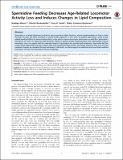Files in this item
Spermidine feeding decreases age-related locomotor activity loss and induces changes in lipid composition
Item metadata
| dc.contributor.author | Minois, Nadège | |
| dc.contributor.author | Rockenfeller, Patrick | |
| dc.contributor.author | Smith, Terry K | |
| dc.contributor.author | Carmona-Gutierrez, Didac | |
| dc.date.accessioned | 2014-07-15T15:01:01Z | |
| dc.date.available | 2014-07-15T15:01:01Z | |
| dc.date.issued | 2014-07-10 | |
| dc.identifier | 132351710 | |
| dc.identifier | 5b8d1d52-620e-4ddd-a7a9-aa13fbed2879 | |
| dc.identifier | 25010732 | |
| dc.identifier | 000338763800100 | |
| dc.identifier | 84904213406 | |
| dc.identifier.citation | Minois , N , Rockenfeller , P , Smith , T K & Carmona-Gutierrez , D 2014 , ' Spermidine feeding decreases age-related locomotor activity loss and induces changes in lipid composition ' , PLoS One , vol. 9 , no. 7 , e102435 . https://doi.org/10.1371/journal.pone.0102435 | en |
| dc.identifier.issn | 1932-6203 | |
| dc.identifier.uri | https://hdl.handle.net/10023/5018 | |
| dc.description.abstract | Spermidine is a natural polyamine involved in many important cellular functions, whose supplementation in food or water increases life span and stress resistance in several model organisms. In this work, we expand spermidine's range of age-related beneficial effects by demonstrating that it is also able to improve locomotor performance in aged flies. Spermidine's mechanism of action on aging has been primarily related to general protein hypoacetylation that subsequently induces autophagy. Here, we suggest that the molecular targets of spermidine also include lipid metabolism: Spermidine-fed flies contain more triglycerides and show altered fatty acid and phospholipid profiles. We further determine that most of these metabolic changes are regulated through autophagy. Collectively, our data suggests an additional and novel lipid-mediated mechanism of action for spermidine-induced autophagy. | |
| dc.format.extent | 11 | |
| dc.format.extent | 792652 | |
| dc.language.iso | eng | |
| dc.relation.ispartof | PLoS One | en |
| dc.subject | QH301 Biology | en |
| dc.subject.lcc | QH301 | en |
| dc.title | Spermidine feeding decreases age-related locomotor activity loss and induces changes in lipid composition | en |
| dc.type | Journal article | en |
| dc.contributor.institution | University of St Andrews. School of Biology | en |
| dc.contributor.institution | University of St Andrews. Biomedical Sciences Research Complex | en |
| dc.identifier.doi | https://doi.org/10.1371/journal.pone.0102435 | |
| dc.description.status | Peer reviewed | en |
This item appears in the following Collection(s)
Items in the St Andrews Research Repository are protected by copyright, with all rights reserved, unless otherwise indicated.

